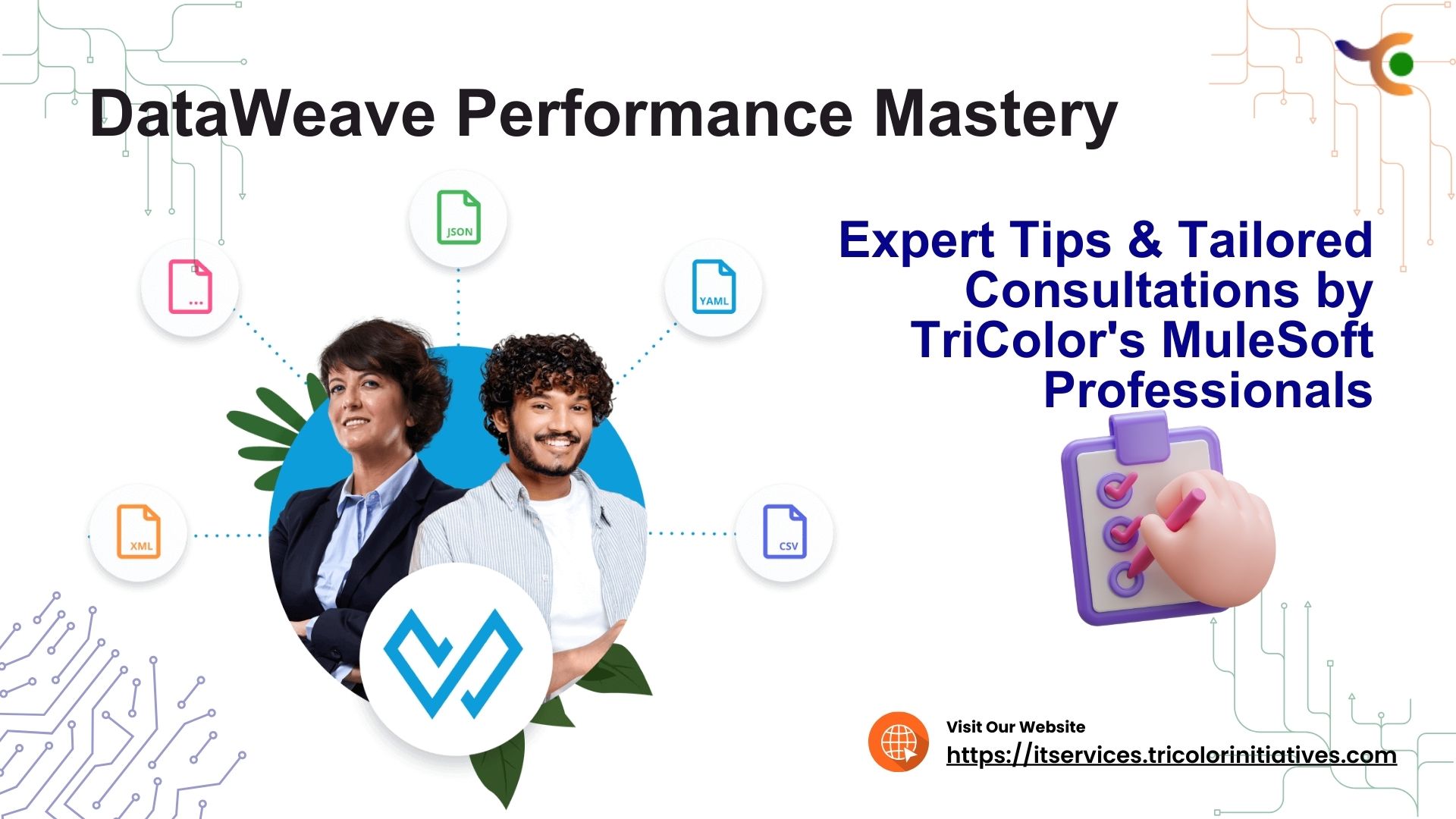What is MuleSoft’s DataWeave?
MuleSoft’s DataWeave is a powerful data integration tool used to transform and manipulate data from one format to another. It supports a wide range of data formats, including JSON, XML, CSV, and others. DataWeave provides a rich set of functions and operators that make it easy to perform data transformation. For example, you can use DataWeave to filter and sort data, perform calculations, and aggregate data from multiple sources. It has declarative syntax and a rich set of functions that make it easy to use and maintain, even for complex data integration tasks.
Overview of Dataweave

DataWeave uses a functional programming approach, allowing developers to easily create complex data transformations using a simple syntax. It has a rich set of functions that can be used to manipulate data, including filtering, sorting, grouping, and aggregation.
MuleSoft’s DataWeave is its ability to handle complex data structures, such as nested objects and arrays. It also provides powerful features for working with these structures, including the ability to access nested data and map data.
Importance of Data Integration and Data Transformation in Modern IT Ecosystem
Data integration and data transformation are critical components of modern IT ecosystems. They enable organizations to effectively manage and use the vast amounts of data they collect from various sources. Here are some of the key reasons why data integration and transformation are so important:
Improved data quality: Data integration and transformation processes can help to ensure that data is accurate, consistent, and complete, improving overall data quality and reducing errors.
Increased productivity: By automating data integration, organizations can save time and resources, enabling employees to focus on higher-value activities.
Enhanced decision-making: By integrating and transforming data from multiple sources into a single, unified view, organizations can gain insights and make more informed decisions.
Improved customer experience: By integrating and transforming data from various sources, organizations can gain a more comprehensive understanding of their customers. It also enables them to personalize interactions and improve the customer experience.
Regulatory compliance: Data integration and transformation processes can help organizations to comply with data privacy and security regulations by ensuring that data is appropriately managed and protected.
What are the Benefits of DataWeave?
DataWeave is a powerful data integration and transformation tool that provides a wide range of features and benefits. Here are some of the key features and benefits of DataWeave:
- DataWeave provides a flexible and intuitive way to transform data from one format to another, including support for complex data structures and a rich set of functions and operators.
- DataWeave supports a wide range of data formats, including JSON, XML, CSV, and others, making it compatible with various data sources and systems.
- DataWeave is highly scalable and can handle large volumes of data with high performance, making it suitable for real-time data integration and processing.
- DataWeave also allows for the reuse of code snippets, functions, and modules, reducing development time and improving code maintainability.
- DataWeave is tightly integrated with the Anypoint Platform, allowing for easy integration with other MuleSoft tools and connectors.
- DataWeave can be used for many use cases, including data mapping, enrichment, validation, and more.
- DataWeave can help improve data quality by transforming and cleaning data from various sources, ensuring consistency and accuracy.
- DataWeave can help organizations make better decisions by providing a unified view of data from multiple sources, enabling insights and data-driven decision-making.
What are the common DataWeave functions and Capabilities?
DataWeave is a powerful data integration and transformation language that offers a wide range of capabilities and functionalities. Here are some of the key features of DataWeave:
Data Transformation and Mapping
DataWeave allows for easy transformation of data between different data formats, including JSON, XML, CSV, and others. Moreover, it provides a powerful set of features for working with complex data structures, including the ability to access nested data and map data from one format to another.
MuleSoft’s DataWeave provides a flexible and intuitive way to map data from one format to another, including support for complex data structures and a rich set of functions and operators. This makes it easy to transform data from various sources into a single, unified view.
Support for Multiple Data Formats
In addition to supporting multiple data formats, DataWeave provides a rich set of functions and operators that manipulate and transform data, including filtering, sorting, grouping, aggregation, and more. Some of the data formats that DataWeave supports include:
JSON: DataWeave provides native support for JSON, enabling easy integration with REST APIs and other web services.
XML: DataWeave also supports XML and provides functions for parsing, transforming, and generating XML documents.
CSV: DataWeave can read and write CSV files, making it easy to integrate with legacy systems that use this format.
Fixed-width files: DataWeave can also read and write fixed-width files, which are commonly used in financial and banking systems.
EDI: DataWeave also supports EDI (Electronic Data Interchange) files, which are commonly used in supply chain management and logistics.
SAP IDoc: DataWeave supports SAP IDoc, enabling easy integration with SAP systems.
HL7: DataWeave supports HL7 (Health Level Seven) messages, which are commonly used in healthcare systems.
Avro: DataWeave provides support for Avro, a popular data serialization format used in big data systems such as Hadoop.
Others: DataWeave also supports other data formats such as YAML, HTML, and plain text files.
Integration with Anypoint Platform
DataWeave is a powerful data integration and transformation language that is tightly integrated with MuleSoft’s Anypoint Platform. Here are some of the key capabilities and functionalities of DataWeave when integrated with the Anypoint Platform:
Data Mapping: DataWeave allows developers to easily map data from one format to another. It includes support for complex data structures and a rich set of functions and operators. It also supports advanced mapping features like conditional logic, looping, and error handling.
Data Enrichment: DataWeave can enrich data by combining data from multiple sources or by adding additional data based on certain conditions. For example, it can add geolocation data to customer records based on their IP address.
Data Validation: DataWeave can validate data by checking for consistency, completeness, and accuracy. And it can also transform data to meet specific validation requirements.
Data Filtering and Sorting: DataWeave can filter and sort data based on specific criteria, such as date range, location, or other attributes.
Modular Code Development: DataWeave supports modular code development, allowing developers to reuse code snippets, functions, and modules across multiple projects, reducing development time and improving code maintainability.
Integration with Anypoint Connectors: DataWeave can integrate with Anypoint Connectors, which are pre-built integrations that connect to various systems and applications. It allows for easy integration with other systems and data sources.
Real-World Use-Cases of DataWeave
DataWeave is a versatile tool that uses for a wide range of data integration and transformation use cases. Here are some real-world use cases of DataWeave:
Consolidating data from multiple sources
MuleSoft’s DataWeave is a powerful tool for consolidating data from multiple sources. However, it uses a wide range of real-world use cases. Here are some examples of how DataWeave consolidates data:
- Consolidating Customer Data: DataWeave consolidates customer data from multiple sources, such as CRM systems, and social media platforms. By reducing customer data into a single view, businesses can better understand their customers, and use this information to personalize interactions and improve the customer experience.
- Consolidating Sales Data: DataWeave consolidates sales data from multiple sources, such as POS systems, eCommerce platforms, and sales analytics tools. By reducing sales data, businesses can gain insights into sales trends and patterns, and use this information to make data-driven decisions.
- Consolidating Financial Data: DataWeave consolidates financial data from multiple sources, such as accounting software, and banking systems. By reducing financial data, businesses can gain a holistic view of their financial performance, and use this information to optimize their financial processes and improve their bottom line.
- Consolidating Healthcare Data: DataWeave consolidates healthcare data from multiple sources, such as electronic medical records, and health monitoring devices. By reducing healthcare data, healthcare providers can gain a comprehensive view of patient health, improve care coordination, and optimize healthcare delivery.
Data Transformation for API Consumption
DataWeave is a powerful tool for transforming data for API consumption, and it is widely used in a variety of real-world use cases. Here are a few examples:
- E-commerce product data integration: E-commerce platforms often need to integrate product data from multiple suppliers, each with different formats and structures. DataWeave transforms this data into a standard format for consumption by the platform’s API.
- Supply chain data integration: Supply chain systems often need to integrate data from multiple suppliers, logistics providers, and shipping carriers. DataWeave transforms this data into a standard format for consumption by the supply chain system’s API, enabling better visibility and analysis of the supply chain.
- Social media analytics: Social media platforms often need to integrate data from multiple sources, such as user posts, comments, and likes. DataWeave transforms this data into a format that can be consumed by the platform’s API, enabling better analysis and insights into user behavior.
Tips for Implementing DataWeave Effectively
Here are some tips for implementing DataWeave effectively:
- Understanding Data Requirements and Formats
- Leverage DataWeave’s Built-in Functions
- Collaborating with MuleSoft Professional for Guidance
Understanding Data Requirements and Formats
Familiarize yourself with the structure of the input data and the desired output format. This will help you write DataWeave transformations more efficiently. Learn the DataWeave syntax and functions to effectively manipulate and transform data. Understand concepts like mapping, filtering, aggregating, and handling null values.
Leverage DataWeave’s Built-in Functions
DataWeave provides a wide range of built-in functions for various data operations. Familiarize yourself with these functions and utilize them to simplify your transformations and data manipulations.
Collaborating with MuleSoft Professional for Guidance
Seek guidance from MuleSoft’s professionals or engage in the MuleSoft developer community to learn best practices, share experiences, and get assistance with specific DataWeave challenges. Collaborating with experts can help you enhance your DataWeave skills and stay up-to-date with the latest features and improvements.
Ensuring Data Quality and Compliance with DataWeave
When using DataWeave to ensure data quality and compliance, consider the following tips:
- Implementing Data Validation and Error Handling
- Protecting Sensitive Data during Transformation
- Adhering to Data Governance best practices
Implementing Data Validation and Error Handling
DataWeave allows you to perform data validation and handle errors gracefully. Implement appropriate error-handling mechanisms, such as using the try and catch blocks, to handle exceptions and provide meaningful error messages. Begin by validating the input data against predefined rules or schemas to ensure its integrity and adherence to compliance requirements. Leverage DataWeave functions like matches, isBlank, isNumber, or custom validation logic to perform data validation.
Protecting Sensitive Data during Transformation
Implement data masking techniques to replace sensitive data with fictitious or masked values. This ensures that sensitive information is not exposed during transformation. MuleSoft provides various functions and techniques to achieve data masking in DataWeave. Use secure protocols, such as HTTPS, when transmitting sensitive data between systems. Encrypting data in transit adds an extra layer of protection and minimizes the risk of unauthorized access.
Adhering to Data Governance best practices
Establish robust data governance practices to maintain data quality and compliance. Define data standards, documentation, and processes for handling sensitive data. However, regularly audit and monitor the data transformation activities to ensure adherence to policies and regulations. Define proper data retention and deletion policies to manage sensitive data effectively. Ensure that sensitive data is retained only for the required duration and is securely deleted.
Conclusion
In conclusion, DataWeave is a powerful tool provided by MuleSoft that enables seamless data integration in your applications and systems. By following best practices and leveraging its capabilities effectively, you can achieve efficient and reliable data transformations.
Recap of the advantages of MuleSoft’s DataWeave for Seamless Data Integration
DataWeave also empowers developers to seamlessly integrate data from various sources, perform complex transformations, and ensure the quality and reliability of data across their integration projects.
TriColor Initiatives personalized DataWeave Consultation
Ready to take your data integration to the next level with DataWeave? Schedule a personalized DataWeave consultation with TriColor’s expert MuleSoft professionals today!
During the consultation, our team will work closely with you to understand your specific data integration needs, provide guidance on DataWeave best practices, address any challenges you may be facing, and help you optimize your data transformations.
Whether you’re a beginner looking to learn the fundamentals or an experienced developer seeking advanced techniques, our experts are here to assist you every step of the way. Don’t miss this opportunity to unlock the full potential of DataWeave and achieve seamless data integration in your projects. Contact us now to schedule your personalized DataWeave consultation and embark on a journey to transform your data integration capabilities.






